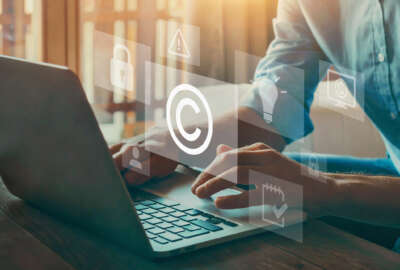
One small agency marks success in modernizing an old process
The Copyright Office — a Congressional agency — is taking a bow for the success of its online recordation system. The system lets people submit, online,...
The Copyright Office — a Congressional agency — is taking a bow for the success of its online recordation system. The system lets people submit, online, documents for copyright applications. How successful is it? Federal Drive with Tom Temin gets the numbers from the Assistant Register and Director of the Office of Copyright Records, Denise Wofford.
Interview Transcript:
Tom Temin And let’s begin with what it is that the records system records, that is, what sorts of documents do people need to get into the Copyright Office, aside from the work that they’re trying to copyright itself, is that also part of it?
Denise Wofford Yeah, Tom, that’s really a great question because a lot of people get the copyright registration confused with recordation. And the recordation is really about transferring your copyright over to someone else. And so we have a lot of artist creators and authors, lawyers who are working with individuals who transfer copyrights over to other individuals. So, for example, let’s say, Tom, you write a novel and then someone comes to you and they say that they want to make that novel into a movie. And so you may transfer part of your copyright over to that movie producer so that they could make that movie for you. We do a lot of copyright recordation’s in the office, and it’s all part of making the public record a complete record in terms of the copyright ownership.
Tom Temin Understood. So before this system was piloted, how did this happen? It was all paper by mail, basically.
Denise Wofford Yes, Tom, it was all paper by mail. It was very time consuming, it was a long process. People basically mailed in their paper documents along with their title words, and we would actually literally record that information manually into our indexing system. So it took a lot of time to do that process, as you can imagine. Our recommendation specialists would have to contact people to ensure that they were entering the information correctly. A lot of times the fee might not be correct, and so the process was very long. And so now with this new modern system, everything is done online, is streamlined and it’s much, much better. And we’re getting really good results out of the new system now. Things are being processed in weeks versus months under the paper process.
Tom Temin And looking at the site itself, there is a lot of types of paperwork. There’s 11 different types of documents. And give us a sense of the volume of how many applications come in for this recordation every year, how many transactions, and how many are now being done electronically versus a year ago before the pilot?
Denise Wofford Yeah, a year ago, we roughly processed five to 6,000 documents annually. Now we’re seeing the volume increase significantly. CISA was first piloted in April of 2020. Since that time, we’ve recorded over 19,000 documents, but just under a million titles of work. So it’s a significant improvement in terms of the use of the system. We’re very pleased because people have really engaged with the system and now we’re starting to see more documents being recorded because of that.
Tom Temin And it looks like you still need to add more documents that are not yet supported by the system. Again, according to the website, notices of termination declarations of ownership in musical works and so on. What is the issue there? And do you plan to add those?
Denise Wofford Yes, Tom, So we’ve developed the basic documents of the 205 documents, that work is been completed. And under our continuous development process, we are planning on adding the additional documents that aren’t currently available in the online system. So that would be the notices of terminations and the other documents that currently are not recorded.
Tom Temin And I notice that documents not compatible are those, for example, with more than 10,000 works, including alternative identifiers and so on, who’s got 10,000 things that they would transfer in the first place? Is this like Taylor Swift or Bob Dylan or something assigning their works?
Denise Wofford So actually that does happen quite a bit. We have law firms and organizations that have quite a bit of number of works. It could be photographs, it could be music. And so we do get often a lot of titles of works that we have to actually record. It could be hundreds of titles of works. So it does happen.
Tom Temin And what form can these different types of documents be in? Because they could be, I guess, word documents, PDFs, JPEGs, whatever the case might be. Can the system, as it is, accept all of these different formats?
Denise Wofford Yes, it can, Tom. So most of the documents that come into us are either in word format or PDF format. Those documents are uploaded as part of the system. But the way the online system works is you actually input all of the key information directly into the system. The document is uploaded as part of that whole package that’s submitted to our office.
Tom Temin All right. And when people have documents that are not yet supported by the system. Along with documents that are supported, then you’ve got kind of a hybrid. There still might be paper associated with a let’s call it a case, for lack of a better word. How do you correlate what might be in a file cabinet with what you were able to get online?
Denise Wofford Well, for the ones that are not supported through the system, we still have the mail in process that’s still available to the public to use. And we are looking and working right now to expand the system to allow all of the different types of documents, like the notices of termination to be included in the system as well.
Tom Temin But you can correlate those with what you have online, with what you might have physically. There’s some way of identifying this goes with that. If one thing is in the system and something else is in a file cabinet.
Denise Wofford So when you submit to the office, your options are either submit online through the online system or submit a paper, not both ways. So everything that you would submit to us online would be done through the online system and it will accept whatever documents you submit to us through the online system. And Tom, we should note that those documents have to be PDFs uploaded into the system.
Tom Temin And how did you develop this was an in-house staff. Did you use a contractor? And how’s that all going?
Denise Wofford Well, actually, that’s a very good question. We actually have in-house staff, as well as contractors that are supporting this effort under the enterprise copyright system, modernization effort that’s underway. And so that process has been going very, very smoothly. We are currently using the scale Agile model to actually do the development, which is allowing us to roll out the software in phases.
Tom Temin Interesting. And earlier I asked about the copies of the works that are being copyrighted that, as you said, a different process here than the reassignment of the copyright. But on that initial front end, how are things going electronically? Is that also being electronicfide, so to speak, for people that make the initial copyright application?
Denise Wofford So, yes, Tom, we actually have an existing system in place that was an online system for the copyright registration component. We are currently in the process of actually modernizing that part of the system as well. And so that is currently under development and we’re looking forward to being able to launch a pilot soon on that.
Tom Temin And you mentioned 205 documents. That’s a legal reference to the enabling legislation for all of this?
Denise Wofford That is exactly correct. As you know, Tom, the US Copyright Office is based off of Title 17, the US Copyright Act. And so Title 17 defines the actual procedures and regulations and rules that govern what we do within the US Copyright Office. And so 205 documents fall under Title 17.
Tom Temin And this is often confusing to the public, but the other types of ownership modes, patents and trademarks, of course, those exist in the executive branch under the Commerce Department. And do you ever talk to those people or do they talk to you? Because even though one is congressional, one is executive, they have a theme. This is my work, and I want it to be protected in some manner. Again, patents and trademarks over their copyrights over here. But do you all ever trade ideas and trade methodologies ever?
Denise Wofford Yes. As you know, patent and trademarks are slightly different than copyright. We work very closely with the Patent Trademark Office because it’s all about intellectual property, and so we work very closely with them. In terms of the copyright law, we are focused on things that are related to creative works. They could be paintings, photographs, sculptures, jewelry, illustrations, musical compositions, I mean, various types of things. Textile designs and a lot of other things are copyrighted, all considered intellectual property.
Tom Temin And getting back to the recordation system, it’s still called a pilot. At what point will it be declared a system of record and it’s there forever or until the next update?
Denise Wofford Well, the system is still called pilot, and it’s called a pilot because of the legal rules around it. But the system is actually live. And so the information that’s being processed through the system is actually official information that is being updated into the copyright public record system.
Copyright © 2024 Federal News Network. All rights reserved. This website is not intended for users located within the European Economic Area.
Tom Temin is host of the Federal Drive and has been providing insight on federal technology and management issues for more than 30 years.
Follow @tteminWFED
Related Stories





